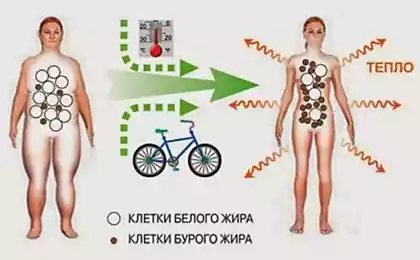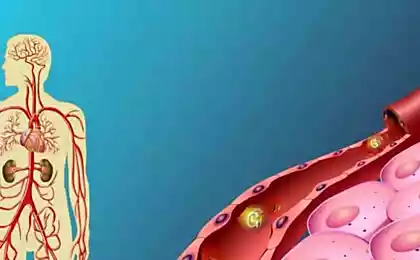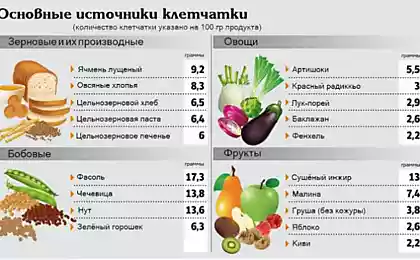721
Subcutaneous fat: no fat, no abundance
O fat subcutaneous say a word... Say, and not one. Subcutaneous fat does not cause inflammation and does not produce bad C-reactive protein. Moreover, subcutaneous fat produces a lot of leptin and adiponectin. Starting a fight with the subcutaneous fat, you can do serious harm. Why?
Now we see why. In any case it is impossible to greatly reduce the amount of subcutaneous fat. From the point of view of leptin, and reducing subcutaneous fat, we significantly reduce the levels of leptin in the blood, which can switch us to a deficit regime. And it is quite logical – subcutaneous fat is the energy reserve which is always there, no fat, no abundance. You paid, probably, attention, depression and aggression of people who are "skin and bones". While they can be a real excess visceral fat, which is very bad.
I am often asked, for example, about cellulite. So, the cause of cellulite — the inflammation, not the fat. What causes inflammation? Visceral fat, not subcutaneous.

Let's talk about the benefits of subcutaneous fat.1. Appearance. Despite the fashion for teenagers, angular, well developed subcutaneous fat makes a person more beautiful, because it then consists of curves, not angles. In addition, subcutaneous fat is a big part of the Breasts, buttocks, thighs.
2. Subcutaneous fat in the hips has a protective effect for women (but not men). The ideal option is the possession of a few extra pounds in the hips, and nothing more at the waist. Very good for health to wear on their thighs and buttocks a few extra pounds, as they protect human from heart and metabolic problems.
3. Subcutaneous fat maintains normal metabolic rate. Advise women to consciously take steps to increase the amount of fat in the hips, prescribing to patients the methods of redistribution of fat on the thighs in order to protect them from cardiovascular disease and metabolic diseases such as diabetes. According to the researchers, those people who have in the hips too little fat can cause serious problems with metabolism.
4. Liposuction and "drying" have serious negative consequences. Internal visceral fat remains, and useful subcutaneous – out. The removal of subcutaneous fat through liposuction the scientists think the big mistake. To improve metabolic processes, contributing to the slimness, it still does not, and the fat pumped out will soon return. According to information published in JAMA, the risk of death in a patient of older age, had undergone surgery to remove excess fat, increases several times. This conclusion was made by physicians from the United States. The total percentage mortality after this plastic surgery is 0.5%. Mortality rates were compared: within 1 month after surgery, 3 months and 1 year after surgery. The percentage of death for these intervals the following are 2%, 2.8% and 4.6%, respectively. It turned out that male patients have died after liposuction in two times more often than women.
5. There are significant sex differences in the amount of subcutaneous fat.Men are more likely to store "bad" visceral fat and less subcutaneous fat, so they carry a low percentage of body fat is good. For women the reverse situation – lower percentage of body fat translates their body in the mode of deficit with all its metabolic and psychological consequences. To do them is absolutely impossible. Yes, subcutaneous fat can also be redundant, but redundancy is a cosmetic in the first place. Of course, a strong excess subcutaneous fat would become inflamed and provoke the growth of visceral fat.
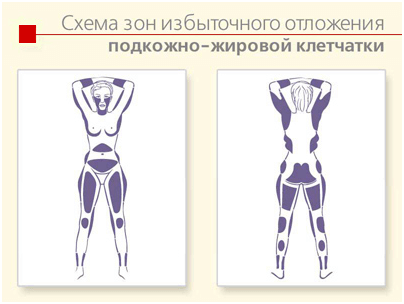
6. Women with pronounced forms live on average longer than the "thin people", found researchers from the Danish Institute of preventive medicine. Women with wide hips are better protected from cardiovascular diseases. At the same time, those who have the width of the hips does not exceed 40 inches (100 cm) have to think about the increase in their volume. Figure shaped like an hourglass, have become the standard of beauty, thanks to the famous women like Marilyn Monroe, Sophia Loren, Kelly brook and — later — Katherine Zeta-Jones. It was found that among women with wide hips mortality rate from cardiovascular diseases was 87% lower than among uncovery women. The risk of developing coronary heart disease they were lower by 86% and cardiovascular disease by 46%. Thus, according to the same study, men the size of the hips does not affect the propensity for heart disease. Fat on hips is different than on the belly. If you have a little of this fat, you risk getting a heart attack.
7. Adiponectin and growth hormone, according to many scientists, plays a important role in life expectancy, it also affects the health status of the elderly. It is the opinion of the participants of the Congress of neuroendocrinology held in Pittsburgh. In their recent study involved women over 102 years, there were 25 of them. Are in good condition and a life expectancy researchers have linked high levels of the hormone Adiponectin.
Subcutaneous fat and adiponectin. Subcutaneous fat especially on the thighs and buttocks, develops special protective substance adiponectin. The less subcutaneous fat, the less adiponectin. Inflammation and visceral fat also reduces levels of adiponectin. Adiponectin controls insulin sensitivity and is known to play an important role in metabolism and obesity. Previous studies have shown that high levels of adiponectin the body stores excess fat in adipocytes, or fat cells to protect itself from possible starvation in bad times. These fat reserves are deposited mainly in the subcutaneous tissue, and the expression of adiponectin in subcutaneous fat is higher than in the visceral. Adiponectin is a specific adipokine, i.e., it is synthesized only by adipocytes. Expression, secretion and plasma levels of adiponectin decrease with obesity and abdominal distribution of adipose tissue. There is a kind of paradox: the more pronounced visceral obesity and the more adipocytes, the less they produce adiponectin.
By reducing hormone levels the body begins to Deposit fat in dangerous places (visceral obesity), such as the heart, liver and muscle tissue where it can cause inflammation and lead to heart disease. Therefore, scientists believe that the level of adiponectin may be a good predictor of risk of developing diabetes, heart disease and cancer. There are also strong negative correlation between adiponectin concentration and visceral obesity that was identified during computed tomography.
Adiponectin is important for the prevention of cardiovascular and many other diseases. Its small doses can be used for the treatment of chronic depression. With obesity and depletion of its amount and activity in the blood decreases. Getting into muscle tissue, adiponectin promotes fatty acid oxidation improves insulin sensitivity. Experiments have shown that it has a pronounced anti-atherogenic and anti-inflammatory effects. Elevated levels of hormone adiponectin in the body a person always helps in the healing of such diseases as diabetes.
One of the main functions of adiponectin is oxidation and lipolysis, which in turn prevents the development of obesity. In addition, this hormone increases insulin sensitivity and reduces glucose levels in the blood, which significantly reduces the risk of diabetes. Adiponectin reduces the production of fat in the liver, contributes to lowering blood pressure, prevents the development of atherosclerosis and cardiovascular diseases.
The accumulated data allow to conclude that adiponectin is an important component of the system of the regulation of energy metabolism. The most important effects of adiponectin are:
It possesses protective properties:
Decrease adiponectin level leads to deposition of fat in the heart, liver and muscle tissue, which can cause the occurrence of inflammation in the blood vessels and cause heart disease. Thus, the concentration of adiponectin in blood is advisable to assess the risk of developing diabetes, heart disease and pancreatic cancer (according to recent data, and reduced levels of adiponectin increases the likelihood of developing this disease), which most often affects people with obesity and (or) diabetes mellitus.
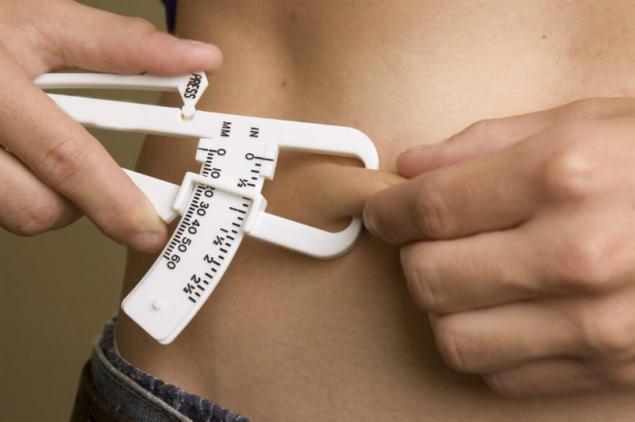
How to measure the level of subcutaneous fat?The so-called instrumental methods include:
By the way, calipatria today is the most popular method of determining body fat and is successfully used in many fitness clubs. The essence of the method is to measure folds of skin all over the body using a special instrument, the downhillers, so the method is called calipatria. Thus, to determine the amount of subcutaneous fat, and special formulas (usually they are instructions to the caliper) calculated total fat content in the body.
The caliper is a small and inexpensive device resembling pliers. After determining the amount of subcutaneous fatty tissue, it is possible to draw General conclusions.
If you don't have the downhillers, can try to estimate the thickness of the fat folds "by eye":
1. Grab with your thumb and forefinger a fold of skin. The distance is about 5 cm.
2. Slightly pull the clutch away from the body. Between the foot pads needs to be two layers of subcutaneous adipose tissue.
3. Make sure that between the toes was not itself bend folds (the cushion).
4. The measurement is performed on the right side of the body.
5. The fold of skin tightly squeeze your thumb and forefinger or three fingers so that her strength would have been skin and subcutaneous fat layer. The fingers have approximately 1 cm above the place of measurement.
6. The legs of the downhillers is applied so that the distance from a crest crease to the point of measurement is approximately equal to the thickness of the folds.
It is recommended to make two measurements of each fold and evaluate the average value.
Measurement of bioelectric resistance is the only method available at home.
There are many firms producing special devices — analyzers of fat. The principle of operation they have one: measuring the electrical conductivity of the body using a weak current to send the unit impulse is completely safe and painless. But such a device does not show abdominal fat or shows with strong errors. Of course, that fat in the liver it will not show.
With the downhillers is measured by 4 indicators on different parts of the body and displays the total figure:
1. Triceps. Measure the fold on the back of the hand, which often swim with fat people obese.
2. Biceps. Measure the fold on the front side of the arm, along the shoulder joint.
3. Blade. Measure the pleat at the level of the scapula, along.
4. The stomach. Measure the size of the folds of the stomach at 10 cm below the navel.
Total: add up all the figures and get the numbers that show the level of fat in the body, depending on gender and age.
Standards of fatty tissue in the body for men and women vary greatly.
For men: 15% -17% of total body weight
For women: 20-25% of total body weight
Or more accurately by age:
The amount in mm. men women 16 – 29 years 30 – 49 years 50 + 16 – 29 years 30 – 49 years 50 + 20 8,1 12,1 12,5 14,1 18,4 21,4 22 9,2 13,2 13,9 15,4 19,5 22,6 24 10,2 14,2 15,1 16,5 20,6 23,7 26 11,2 15,2 16,3 17,6 21,5 24,8 28 12,1 16,1 17,4 18,6 22,4 25,7 30 12,9 16,9 18,5 19,5 23,3 26,6 35 14,7 18,7 20,8 21,6 25,2 28,6 40 16,3 20,3 22,8 23,4 26,8 30,3 45 17,7 21,8 24,7 25,0 28,3 31,9 50 19,0 23,0 26,3 26,5 29,6 33,2 55 20,2 24,2 27,8 27,8 30,8 34,6 60 21,2 25,3 29,1 29,1 31,9 35,7 65 22,2 26,3 30,4 30,2 32,9 36,7 70 23,2 27,2 31,5 31,2 33,9 37,7 75 24,0 28,0 32,6 32,2 34,7 38,6 80 24,8 28,8 33,7 33,1 35,6 39,5 85 25,6 29,6 34,6 34,0 36,3 40,4 90 26,3 30,3 35,5 34,8 37,1 41,1 95 27,0 31,0 36,5 35,6 37,8 41,9 100 27,6 31,7 37,3 36,3 38,5 42,6 110 28,8 32,9 38,8 37,7 39,7 43,9 120 29,9 34,0 40,2 39,0 40,8 45,1 130 31,0 35,0 41,5 40,2 41,9 46,2 140 31,9 36,0 42,8 41,3 42,9 47,3 150 32,8 36,8 43,9 42,3 43,8 48,2 160 33,6 37,7 45,0 43,2 44,7 49,1 170 34,4 38,5 46,0 44,6 45,5 50,0 180 35,2 39,2 47,0 45,0 46,2 50,8 190 35,9 39,9 47,9 45,8 46,9 51,6 200 36,5 40,6 48,8 46,6 47,6 52,3 the Amount in mm.
16 – 29 years30 – 49 years50 +16 – 29 years30 – 49 years50 +menwomen Therefore, the norms of adipose tissue in the body for men and women vary greatly.
Men, too, not so happy. With low fat, 4-6% of the total weight, stops the production of testosterone and reduced libido. Relief – a lot of professional bodybuilders and is harmful.
Conclusion.1. Subcutaneous fat is good, useful and beautiful! Respect her! Subcutaneous fat is your beauty and attractiveness.
2. Adiponectin levels can be measured and controlled. Its values are:
The methods of analysis and reference values in different laboratories may vary and are listed on the letterhead of the study. It is important is to increase adiponectin levels – so you can monitor its progress. Good subcutaneous tissue is high levels of adiponectin.
3. Make sure that the level of subcutaneous fat has not fallen below the norm!
4. Developed subcutaneous tissue protects you from visceral obesity. Great? Also interesting: Find out what visceral fat is and how dangerous it is Hidden fat — the invisible threat To increase levels of adiponectin enough to do 2 simple things:
Source: www.beloveshkin.com/2015/07/vashi-druzya-podkozhnyj-zhir-i-adiponektin.html
Now we see why. In any case it is impossible to greatly reduce the amount of subcutaneous fat. From the point of view of leptin, and reducing subcutaneous fat, we significantly reduce the levels of leptin in the blood, which can switch us to a deficit regime. And it is quite logical – subcutaneous fat is the energy reserve which is always there, no fat, no abundance. You paid, probably, attention, depression and aggression of people who are "skin and bones". While they can be a real excess visceral fat, which is very bad.
I am often asked, for example, about cellulite. So, the cause of cellulite — the inflammation, not the fat. What causes inflammation? Visceral fat, not subcutaneous.

Let's talk about the benefits of subcutaneous fat.1. Appearance. Despite the fashion for teenagers, angular, well developed subcutaneous fat makes a person more beautiful, because it then consists of curves, not angles. In addition, subcutaneous fat is a big part of the Breasts, buttocks, thighs.
2. Subcutaneous fat in the hips has a protective effect for women (but not men). The ideal option is the possession of a few extra pounds in the hips, and nothing more at the waist. Very good for health to wear on their thighs and buttocks a few extra pounds, as they protect human from heart and metabolic problems.
3. Subcutaneous fat maintains normal metabolic rate. Advise women to consciously take steps to increase the amount of fat in the hips, prescribing to patients the methods of redistribution of fat on the thighs in order to protect them from cardiovascular disease and metabolic diseases such as diabetes. According to the researchers, those people who have in the hips too little fat can cause serious problems with metabolism.
4. Liposuction and "drying" have serious negative consequences. Internal visceral fat remains, and useful subcutaneous – out. The removal of subcutaneous fat through liposuction the scientists think the big mistake. To improve metabolic processes, contributing to the slimness, it still does not, and the fat pumped out will soon return. According to information published in JAMA, the risk of death in a patient of older age, had undergone surgery to remove excess fat, increases several times. This conclusion was made by physicians from the United States. The total percentage mortality after this plastic surgery is 0.5%. Mortality rates were compared: within 1 month after surgery, 3 months and 1 year after surgery. The percentage of death for these intervals the following are 2%, 2.8% and 4.6%, respectively. It turned out that male patients have died after liposuction in two times more often than women.
5. There are significant sex differences in the amount of subcutaneous fat.Men are more likely to store "bad" visceral fat and less subcutaneous fat, so they carry a low percentage of body fat is good. For women the reverse situation – lower percentage of body fat translates their body in the mode of deficit with all its metabolic and psychological consequences. To do them is absolutely impossible. Yes, subcutaneous fat can also be redundant, but redundancy is a cosmetic in the first place. Of course, a strong excess subcutaneous fat would become inflamed and provoke the growth of visceral fat.

6. Women with pronounced forms live on average longer than the "thin people", found researchers from the Danish Institute of preventive medicine. Women with wide hips are better protected from cardiovascular diseases. At the same time, those who have the width of the hips does not exceed 40 inches (100 cm) have to think about the increase in their volume. Figure shaped like an hourglass, have become the standard of beauty, thanks to the famous women like Marilyn Monroe, Sophia Loren, Kelly brook and — later — Katherine Zeta-Jones. It was found that among women with wide hips mortality rate from cardiovascular diseases was 87% lower than among uncovery women. The risk of developing coronary heart disease they were lower by 86% and cardiovascular disease by 46%. Thus, according to the same study, men the size of the hips does not affect the propensity for heart disease. Fat on hips is different than on the belly. If you have a little of this fat, you risk getting a heart attack.
7. Adiponectin and growth hormone, according to many scientists, plays a important role in life expectancy, it also affects the health status of the elderly. It is the opinion of the participants of the Congress of neuroendocrinology held in Pittsburgh. In their recent study involved women over 102 years, there were 25 of them. Are in good condition and a life expectancy researchers have linked high levels of the hormone Adiponectin.
Subcutaneous fat and adiponectin. Subcutaneous fat especially on the thighs and buttocks, develops special protective substance adiponectin. The less subcutaneous fat, the less adiponectin. Inflammation and visceral fat also reduces levels of adiponectin. Adiponectin controls insulin sensitivity and is known to play an important role in metabolism and obesity. Previous studies have shown that high levels of adiponectin the body stores excess fat in adipocytes, or fat cells to protect itself from possible starvation in bad times. These fat reserves are deposited mainly in the subcutaneous tissue, and the expression of adiponectin in subcutaneous fat is higher than in the visceral. Adiponectin is a specific adipokine, i.e., it is synthesized only by adipocytes. Expression, secretion and plasma levels of adiponectin decrease with obesity and abdominal distribution of adipose tissue. There is a kind of paradox: the more pronounced visceral obesity and the more adipocytes, the less they produce adiponectin.
By reducing hormone levels the body begins to Deposit fat in dangerous places (visceral obesity), such as the heart, liver and muscle tissue where it can cause inflammation and lead to heart disease. Therefore, scientists believe that the level of adiponectin may be a good predictor of risk of developing diabetes, heart disease and cancer. There are also strong negative correlation between adiponectin concentration and visceral obesity that was identified during computed tomography.
Adiponectin is important for the prevention of cardiovascular and many other diseases. Its small doses can be used for the treatment of chronic depression. With obesity and depletion of its amount and activity in the blood decreases. Getting into muscle tissue, adiponectin promotes fatty acid oxidation improves insulin sensitivity. Experiments have shown that it has a pronounced anti-atherogenic and anti-inflammatory effects. Elevated levels of hormone adiponectin in the body a person always helps in the healing of such diseases as diabetes.
One of the main functions of adiponectin is oxidation and lipolysis, which in turn prevents the development of obesity. In addition, this hormone increases insulin sensitivity and reduces glucose levels in the blood, which significantly reduces the risk of diabetes. Adiponectin reduces the production of fat in the liver, contributes to lowering blood pressure, prevents the development of atherosclerosis and cardiovascular diseases.
The accumulated data allow to conclude that adiponectin is an important component of the system of the regulation of energy metabolism. The most important effects of adiponectin are:
- increasing the sensitivity of tissues to insulin, primarily liver and skeletal muscles
- inhibition of glucose production in liver cells and stimulation of its absorption by the muscles
- stimulation of the oxidation of fatty acids,
- the reduction of intracellular accumulation of triglycerides.
It possesses protective properties:
- prevents obesity, diabetes,
- has anti-atherogenic and anti-inflammatory action.
Decrease adiponectin level leads to deposition of fat in the heart, liver and muscle tissue, which can cause the occurrence of inflammation in the blood vessels and cause heart disease. Thus, the concentration of adiponectin in blood is advisable to assess the risk of developing diabetes, heart disease and pancreatic cancer (according to recent data, and reduced levels of adiponectin increases the likelihood of developing this disease), which most often affects people with obesity and (or) diabetes mellitus.

How to measure the level of subcutaneous fat?The so-called instrumental methods include:
- underwater weighing
- the method is bioelectrical impedance,
- measurement of skinfold thickness using the downhillers.
By the way, calipatria today is the most popular method of determining body fat and is successfully used in many fitness clubs. The essence of the method is to measure folds of skin all over the body using a special instrument, the downhillers, so the method is called calipatria. Thus, to determine the amount of subcutaneous fat, and special formulas (usually they are instructions to the caliper) calculated total fat content in the body.
The caliper is a small and inexpensive device resembling pliers. After determining the amount of subcutaneous fatty tissue, it is possible to draw General conclusions.
If you don't have the downhillers, can try to estimate the thickness of the fat folds "by eye":
1. Grab with your thumb and forefinger a fold of skin. The distance is about 5 cm.
2. Slightly pull the clutch away from the body. Between the foot pads needs to be two layers of subcutaneous adipose tissue.
3. Make sure that between the toes was not itself bend folds (the cushion).
4. The measurement is performed on the right side of the body.
5. The fold of skin tightly squeeze your thumb and forefinger or three fingers so that her strength would have been skin and subcutaneous fat layer. The fingers have approximately 1 cm above the place of measurement.
6. The legs of the downhillers is applied so that the distance from a crest crease to the point of measurement is approximately equal to the thickness of the folds.
It is recommended to make two measurements of each fold and evaluate the average value.
Measurement of bioelectric resistance is the only method available at home.
There are many firms producing special devices — analyzers of fat. The principle of operation they have one: measuring the electrical conductivity of the body using a weak current to send the unit impulse is completely safe and painless. But such a device does not show abdominal fat or shows with strong errors. Of course, that fat in the liver it will not show.
With the downhillers is measured by 4 indicators on different parts of the body and displays the total figure:
1. Triceps. Measure the fold on the back of the hand, which often swim with fat people obese.
2. Biceps. Measure the fold on the front side of the arm, along the shoulder joint.
3. Blade. Measure the pleat at the level of the scapula, along.
4. The stomach. Measure the size of the folds of the stomach at 10 cm below the navel.
Total: add up all the figures and get the numbers that show the level of fat in the body, depending on gender and age.
Standards of fatty tissue in the body for men and women vary greatly.
For men: 15% -17% of total body weight
For women: 20-25% of total body weight
Or more accurately by age:
The amount in mm. men women 16 – 29 years 30 – 49 years 50 + 16 – 29 years 30 – 49 years 50 + 20 8,1 12,1 12,5 14,1 18,4 21,4 22 9,2 13,2 13,9 15,4 19,5 22,6 24 10,2 14,2 15,1 16,5 20,6 23,7 26 11,2 15,2 16,3 17,6 21,5 24,8 28 12,1 16,1 17,4 18,6 22,4 25,7 30 12,9 16,9 18,5 19,5 23,3 26,6 35 14,7 18,7 20,8 21,6 25,2 28,6 40 16,3 20,3 22,8 23,4 26,8 30,3 45 17,7 21,8 24,7 25,0 28,3 31,9 50 19,0 23,0 26,3 26,5 29,6 33,2 55 20,2 24,2 27,8 27,8 30,8 34,6 60 21,2 25,3 29,1 29,1 31,9 35,7 65 22,2 26,3 30,4 30,2 32,9 36,7 70 23,2 27,2 31,5 31,2 33,9 37,7 75 24,0 28,0 32,6 32,2 34,7 38,6 80 24,8 28,8 33,7 33,1 35,6 39,5 85 25,6 29,6 34,6 34,0 36,3 40,4 90 26,3 30,3 35,5 34,8 37,1 41,1 95 27,0 31,0 36,5 35,6 37,8 41,9 100 27,6 31,7 37,3 36,3 38,5 42,6 110 28,8 32,9 38,8 37,7 39,7 43,9 120 29,9 34,0 40,2 39,0 40,8 45,1 130 31,0 35,0 41,5 40,2 41,9 46,2 140 31,9 36,0 42,8 41,3 42,9 47,3 150 32,8 36,8 43,9 42,3 43,8 48,2 160 33,6 37,7 45,0 43,2 44,7 49,1 170 34,4 38,5 46,0 44,6 45,5 50,0 180 35,2 39,2 47,0 45,0 46,2 50,8 190 35,9 39,9 47,9 45,8 46,9 51,6 200 36,5 40,6 48,8 46,6 47,6 52,3 the Amount in mm.
16 – 29 years30 – 49 years50 +16 – 29 years30 – 49 years50 +menwomen Therefore, the norms of adipose tissue in the body for men and women vary greatly.
- For men: 15% -17% of total body weight
- For women: 20-25% of total body weight
Men, too, not so happy. With low fat, 4-6% of the total weight, stops the production of testosterone and reduced libido. Relief – a lot of professional bodybuilders and is harmful.
Conclusion.1. Subcutaneous fat is good, useful and beautiful! Respect her! Subcutaneous fat is your beauty and attractiveness.
2. Adiponectin levels can be measured and controlled. Its values are:
- more than 10.0 mg/ml — low risk of insulin resistance and atherosclerosis;
- to 4.0 mg/ml — high risk of insulin resistance and atherosclerosis.
The methods of analysis and reference values in different laboratories may vary and are listed on the letterhead of the study. It is important is to increase adiponectin levels – so you can monitor its progress. Good subcutaneous tissue is high levels of adiponectin.
3. Make sure that the level of subcutaneous fat has not fallen below the norm!
4. Developed subcutaneous tissue protects you from visceral obesity. Great? Also interesting: Find out what visceral fat is and how dangerous it is Hidden fat — the invisible threat To increase levels of adiponectin enough to do 2 simple things:
- the interval of abstinence and clean between meals (there is only hunger and appetite),
- enough percentage of fat in food.
Source: www.beloveshkin.com/2015/07/vashi-druzya-podkozhnyj-zhir-i-adiponektin.html
We tend to associate happiness with consumption: why we bought, buy and will continue to buy
7 common mistakes in designing a country house




